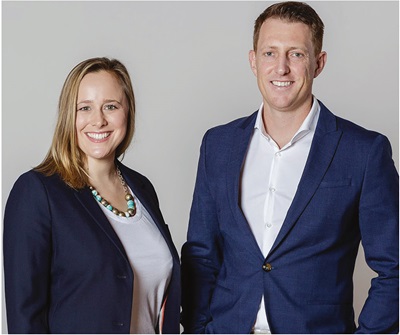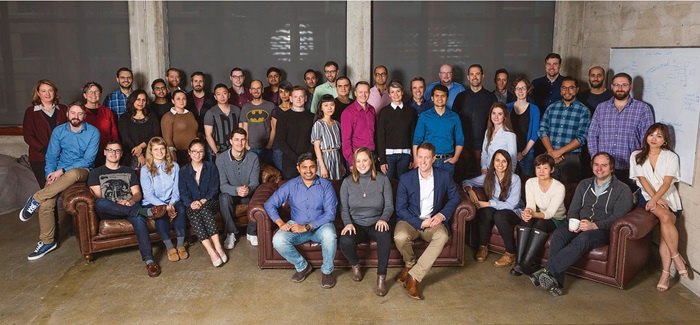
WITH THE DRAGON’S DEN EPISODE about to air, Natalie Cartwright sits on edge. She isn’t nervous about her performance with the Dragons; the filming went well, and she was comfortable on stage. Instead, she’s worried that she and her co-founder, Jake Tyler, are the only people in the room of 40 employees, friends and investors who know that their company is on the verge of collapse. Payso, their free mobile app that sends money between friends, has only a few weeks of cash left in the bank.
Natalie and Jake shot the episode a year earlier, when Payso was on an upswing. And since their contract with the CBC had prohibited them from disclosing whether they had taken financing from the Dragons, they decided to throw a party at their Gastown office to celebrate the episode and reveal what had happened. In the Den, they’d had an offer of $100,000 for 20 per cent of the company, and while the capital would have helped, it wouldn’t have changed the fact that Payso wasn’t growing fast enough, so they turned it down.
The episode opens with Natalie pulling out a large knife and lopping the top off a bottle of champagne to celebrate the Den’s 10th anniversary. Cheekily, she asks the Dragons, “Do you have any change?” to demonstrate the difficulty of splitting the tab in an increasingly cashless world. Jake says he has the solution to their bill-splitting dilemma: Payso, an app that allows people to send money as easily as sending a text message. The Dragons seem intrigued but aren’t willing to make an offer that’s rich enough. The co-founders appear unfazed as they walk off set, arms around each other.
With the episode over, the office applauds and Natalie pulls out a ceremonial sabre and energetically shears the top off a bottle of Beringer. The co-founders sincerely thank everyone for couches they’ve crashed on, promotional help and their friends’ encouragement through the tough points in building a start-up. But as the evening winds down, Jake and Natalie don’t say much. They’re both thinking the same thing: They will need to pull the team together very soon to tell them they’re shutting down.
The Winding Path to Success
Fast-forward two and a half years and Jake, now 35, is the CEO of Finn AI, a blockbuster Vancouver start-up pioneering conversational intelligence in banking apps on a global scale. Finn makes artificial intelligence (AI) software for consumer-facing financial institutions—banks and credit unions such as BMO, ATB Financial and the Commonwealth Bank of Australia — who host the company’s technology under their own brands. The software gives customers better access to their bank accounts and various personal finance tools.
Natalie, also in her early thirties, is COO at Finn and has watched it grow from the two co-founders to over 50 employees in the past 15 months, with no signs of slowing down. One of the company’s investors, Hootsuite co-founder David Tedman, calls it “the fastest growing business I have ever been a part of.”
Finn is competing in a busy space where venture capital dollars are flowing into artificial intelligence with dot-com exigency, and massive players like IBM and Microsoft are securing much of the high ground. But as a highly verticalized product, Finn competes with a relatively small number of players who are mapping the specialized needs of banking customers. By analogy, you could think of IBM’s Watson as trying to learn all the languages in the world at once, while Finn is immersing itself in the local culture of users in a single region, making its machines more fluent in ‘the language of money’.
While Finn and Payso might sound nothing alike, they are the same company. The route the company took from fledgling consumer app to cutting-edge AI platform for big business was anything but straight. In fact, their story somewhat dispels the notion of the founder who receives a sudden iPhone-like vision and then deftly conjures it into being. It does, however, reinforce the narrative that hustle, persistence, and most crucially, agility are needed to take a company from start-up to stay-up. The team’s journey began in 2014 when Jake called Natalie, his former classmate at Spain’s IE Business School, and asked, “Do you have Venmo in Canada?” Back in Vancouver, Natalie replied, “If we do, I’m not aware of it.” Venmo was the market-leading mobile payment app in the U.S., and Jake saw an opportunity to replicate its business model in another country.
 |
It started with two: Natalie Cortwright and Jake Tyler,
co-founders of Payso and Finn AI. |
Although the pair had been friendly with each other, they were really just acquaintances. Nonetheless, Natalie sensed Jake’s commitment to this idea and told him, half in jest, “If you come to Vancouver for this, I’m in!” Two weeks later she was at the airport to greet him with his bike, snowboard and the wry smile she’d come to know well. Within a few short weeks, Jake was living a couple of floors below Natalie in her parents’ basement, sketching out the plans for Payso, the app he saw as Canada’s Venmo. The co-founders’ decisions to save cash for the start-up by spending an ‘intense’ few months in close quarters showed them that their relationship as colleagues could handle the strains of entrepreneurship.
In 2015, there was a growing belief that the large incumbent banks would suffer — and possibly die — as fintech start-ups gradually lured customers away with better customer experiences. With user traction and some key endorsements, Payso showed early promise. It was accepted to a national start-up accelerator called Highline and to pitch on Dragon’s Den. Natalie sought out some introductions from her brother Jon Cartwright — a successful start-up builder in his own right, with key roles at Food.ee and Zolo.ca. One of the meetings Jon set up was between Jake and David Tedman at a bar in New York City, which led to Tedman writing the first external cheque to fund Payso.
Chatting over coffee at one of Vancouver’s best known tech hangouts, Tedman is decidedly understated in describing his role in helping found Hootsuite — one of the town’s biggest success stories — along with Ryan Holmes and Dario Meli. But when I ask what it takes to succeed as an entrepreneur, it’s clear he has given this a lot of thought. His views centre on the ability of founders to readily accept every challenge that comes their way and constantly reorient their thinking to stay on the winding path to success.
Tedman admits that he wasn’t bowled over by the Payso pitch when he first heard it. He’s often skeptical of founders who say they’re ‘creating Uber for X’ — assuming that the playbook of a successful, well-known business will work in another context. On the plus side, Tedman did like Payso’s diverse, hardworking team. At the time, Chief Technology Officer Guru Sivananda was living in India and essentially coding non-stop to get a beta version of Payso out the door for market testing. Tedman saw that the genial and highly committed CTO was the essential ‘third leg of the stool’, and he really liked the way the team displayed humility, a strong work ethic and mutual respect. They were quite unlike the cavalier, brash founder types that some VCs are fond of investing in.
In the stories of successful start-ups, it is common to find founders who started with a deep conviction about customers’ needs, but no objective proof that their business will work. Airbnb’s founders, for example, faced innumerable rejections from investors, who thought the idea that people would pay to sleep on someone else’s air mattress was ludicrous. Similarly, in the early days of SpaceX, Elon Musk couldn’t point to any examples of private companies building space-ready rockets for less than hundreds of millions of dollars. Although both companies ultimately attracted hundreds of millions in capital, the vast majority of the funding didn’t arrive until after the founders had braved the ‘pitch-and-pray’ phase — the traverse from ‘zero to one’, as Peter Thiel put it in his book of the same title.
Finn AI’s clients number in the low double-digits—but their combined market cap is over $200 billion.
In the Payso team’s case, the classical wisdom imparted at business school was to extensively research a market before entering it. Yet if the founders had followed that advice, they would have likely been deterred from starting the business. In contrast to the narrative of the founder who pictures in high definition how their idea will be used by society, it seems the reality for many business creators is akin to the role of Bruce Willis’ character in The Sixth Sense, whose vision is so obscured by a drive to succeed that he doesn’t allow for the possibility of having a six-inch hole in his torso. By willing selective aspects of reality out of their consciousness, these people are capable of feats that literally defy logic.
The ‘hole’ in Payso’s argument was that Canada was not a big enough market to create an independent Venmo. Jake and Natalie recount investor pitches where they would say that, as first mover, Payso had a good chance of taking the entire Canadian market. Hearing this, some investors would say, in effect, ‘So what? Even if you did, the return you can generate in this market is not enough to justify the amount of money you want to raise.’ The founders heard this a few times, and though it nagged at them, they didn’t truly internalize it until later fundraising troubles prompted them to face the issue head on.
Meanwhile, the launch of the Payso app went well. As promised, it enabled users to send money between cellphones without transaction fees. Their small marketing team was able to find a number of groups — student clubs at McGill and UBC — that would have their members download the app in order to participate in social events and outings. The problem was that Payso didn’t receive any revenue from its customers, and it cost an average of $5 in advertising to acquire each new user. With no immediate revenue model, success would probably have required the company to be acquired by a financial institution that could find value in Payso’s users by selling them other banking products.
When they ultimately shut down their peer-to-peer cash exchange, the company had 10,000 customers who had made about $1,000,000 in payments through the network. Today, Finn AI’s clients number in the low double-digits — but their combined market cap is over $200 billion. No longer constrained by a single nation’s economy, the user base spans five countries and four languages.
A walk through Finn’s Yaletown office shows that they are clearly expecting more growth. There is a large, unused area at the front — not far from the desk where, day and night, Sivananda can still be found hammering out code, but now as a permanent resident under Canada’s start-up visa program (along with his wife and young children).
The company’s business model has evolved drastically since the Payso days. Instead of paying out-of-pocket to acquire customers that might be purchased someday by a financial institution, Finn now generates regular recurring revenue from banks. In addition, the exposure it has to millions of banking customers enables the team to continually enhance the intelligence of its system. The anonymized data they receive from every consumer interaction grows their dataset of global banking customer needs. As Jake explains, “what people in Nicaragua want from their banks isn’t drastically different from what people in Canada want, and we see similar trends in Europe and South Africa. We’re learning from our customers.”
In an even more notable turn of events, much of Finn’s business is now financed out of revenue. This has not stopped the team from raising millions in growth capital from well-known investors such as Yaletown Venture Partners and Flying Fish Ventures. Jake and Natalie envision acquiring customers rapidly and have brought in capital to accelerate marketing. Recent fundraising efforts culminated in $14 million financing. Such a milestone would have felt very distant to the founders after their first few months on the road raising funds for Payso.
To stay on the path to success, start-up operators sometimes need to tell themselves a happy story to keep their spirits up. Other times, they need others to do it for them. One such occasion was perhaps the turning point in Payso’s fortunes. It was an enigmatic conversation between Tedman and Natalie over lunch at a Gastown coffee shop full of young freelancers hunched over Macbooks. Tedman had asked Natalie to meet him for an update and she had been dreading it. She had no good news to share: After 24 months of working on Payso, all the funds Tedman and his friends had put into the company had been reduced to a double-digit bank balance.
When Natalie reached a point in the conversation where she felt she had to acknowledge this, she was surprised by Tedman’s ambivalence. She recalls saying, in effect, “Dave, we have $76 left in our bank account. I’m so sorry.” Looking straight at her, his only reaction was a slight nod of the head. At the end, Tedman assured Natalie that the team would somehow figure this out.
Finding a Way Out
How could a small company with no money and essentially no staff not only escape oblivion, but emerge with a new identity in one of the hottest market sectors around? The answer lies in the art of the pivot — a life-saving swerve that few start-up founders have the agility and resilience to execute.
Jake returned to Silicon Valley with no remaining preconceptions or inhibitions. At the time, any number of CEOs of established tech companies had the resources to muscle into the market for AI banking tools, but Jake was among the few who were truly ready for the next big thing.
Around this time, Facebook had been signalling it would start offering commerce inside its Messenger service, and at its F8 developer conference, the company formally invited outside developers to build chatbots for the service. With a mix of good luck and laudable foresight, the Payso team had been experimenting
with similar functionality offered by the workplace collaboration company Slack, which enabled users to call in a money transfer while they were chatting back and forth on the platform. Slack itself was actually a good case study for the Payso team because the product had grown shockingly fast out of another business that ultimately didn’t succeed.
Slack’s Canadian founder, Stewart Butterfield, had twice started video gaming companies that shut down after producing highly popular innovations — first Flickr and then Slack. Similarly, ‘Finn by Payso’ emerged as an offshoot that took far deeper root than anyone anticipated. Sensing some early changes in the market, Tedman and Jake wondered together: ‘Could we ride the crest of Messenger for banking?’ They noticed WeChat, the equivalent of Facebook in China, was having runaway success with this model and it spurred them on.
When asked about the key parts of Payso’s recovery, Jon observed that you need to “listen to your customers about what they really need. You may find there’s a much larger opportunity if you take the time to listen.” This trait distinguishes Jake and Natalie from any number of founders who don’t ultimately find their way. When critiques pile up, it’s common for people — particularly driven, intelligent ones — to shut the world out and cling even more tightly to the views they hold as true.
 |
| The Finn AI team continues to grow. |
In early 2016, Payso had been accepted to a fintech accelerator in Silicon Valley called Plug and Play, and Jake found that the financial institutions he was pitching were really warming to the idea of ‘WhatsApp for banking’. By invoking the name of the wildly successful global messaging app that Facebook had purchased for billions, Jake was again using the ‘Uber-for-X pitch’ that Tedman had warned against—but it was working. It became clear over a number of weeks that ‘bots for banks’ would soon be in high demand.
Tedman liked the strategy of ‘selling pickaxes in a gold rush’ and leaning in to the growing demand banks were facing — helping them rather than competing with them. Looking at the market, they found that Kasisto, a company that had spun out of the research institute that developed much of Apple’s Siri AI interface for the iPhone, was the only company with a meaningful presence in banking. Other than that, the playing field was wide open.
Despite the fresh new thinking, Finn now faced a major hurdle. It needed tens — maybe hundreds — of thousands of dollars to properly test a chatbot product. Yet it wouldn’t be able to raise money from new angel or VC investors because too much capital had already been put into an idea that didn’t pan out — essentially shackling the company to the investors who stood to lose their equity if the business folded.
The leadership team called a meeting of the entire investor syndicate in March of 2016 to pitch the new story. It was clear to everyone that the meeting would either be the pin to hold the pivot together or the joint that would buckle with the pressure of investor fatigue.
The team had been working ceaselessly to explore the pivot and they put everything they had into the meeting. On the wall of their boardroom, they mapped out the key themes and potential turning points of the conversation. Jon, Tedman and Jake deliberated on who to ask first for support and how they might build emotional momentum as the call went on.
When the hour came and Jake dialled into the conference line, there was no way to know which way things would go. He had almost a sense of detachment as he began laying out the company’s new plan. In the end, the group’s efforts were enough: Cheques started dropping like rain — sporadically at first, and then in a deluge. The company built up a strong balance sheet as it climbed through higher and higher tiers of customer approval — first in Canada and then the world.
In closing
Today, Finn AI sits on top of a sound base of technology and data. Nevertheless, it needs to continue moving fast to secure as much of the growing market for financial AI as possible. It could soon seek to raise a large round of capital from leading U.S. VCs to get the fuel needed to maintain its trajectory.
Roadshows and fundraising at that level will bring a whole new set of challenges, but the founders seem as ready as ever to make the most of their company’s strengths and drive it to the next level. When I recently met Natalie at Finn’s office, we found ourselves standing in front of a wall that features every employee’s
picture. “The clearest sign of our success,” she told me, “is the quality of people we are attracting to work with us.”
The ceremonial sabre from the Dragon’s Den is mounted prominently above the wall of photos. As corporate touchstones go, it’s quite evocative — bringing to mind legends of brave knights emboldened by their ideals. And perhaps that’s one way to view the twisty, challenging start-up journey: as a modern-day mythic quest that requires both courage and resilience. Those without a sword need not apply. 
This article appeared in the Winter 2019 issue. Published by the University of Toronto’s Rotman School of Management, Rotman Management explores themes of interest to leaders, innovators and entrepreneurs.
Share this article: